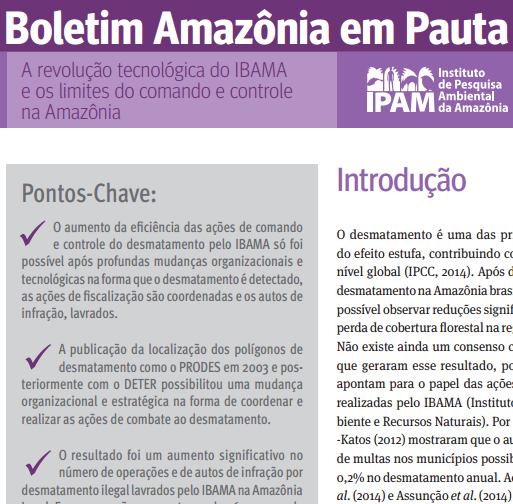Os incêndios no Brasil em 2024 geraram níveis históricos de emissões
O objetivo deste policy brief foi estimar as emissões brutas de gases de efeito estufa causadas pelos incêndios de 2024 no Brasil e destacar a relevância desse componente no perfil de emissões do país. Para isso, desagregamos a análise das áreas afetadas pelo fogo...
Amazônia em Pauta 4: A revolução tecnológica do IBAMA e os limites do comando e controle na Amazônia
O desmatamento é uma das principais fontes de gases do efeito estufa, contribuindo com 15% das emissões em nível global. Após décadas de altas taxas de desmatamento na Amazônia brasileira, entre 2005 e 2012 foi possível observar reduções significativas na...
The linkages between photosynthesis, productivity, growth and biomass in lowland Amazonian forests
Understanding the relationship between photosynthesis, net primary productivity and growth in forest ecosystems is key to understanding how these ecosystems will respond to global anthropogenic change, yet the linkages among these components are rarely explored in...
Código Florestal: por um debate pautado em ciência
O estudo mostra, analisa dezenas de estudos científicos disponíveis e pretende ser um primeiro passo na popularização do tema, em busca de um maior envolvimento da sociedade brasileira.
Greenhouse Gas Measurement and Management
Greenhouse gas (GHG) emissions from agriculture together with forestry (including land-use changes (LUC)) are responsible for nearly 30% of global anthropogenic emissions (IPCC, 2007), but the mitigation potential of these sectors is significant.
Desmatamento na Amazônia até 2013
Mapa produzido pelo IPAM indica áreas desmatadas na Amazônia até 2013, ano que foi auferido aumento de 28% em relação a 2012. Neste ano foram desmatados 5.843 km2.
Caminhos para o Futuro que Queremos – Finanças Verdes: Cenário Brasileiro
No presente artigo os autores apresentam alguns dos principais instrumentos econômicos e incentivos financeiros previstos pela legislação brasileira tanto quanto aplicados pelos governos a nível nacional ou subnacional.




